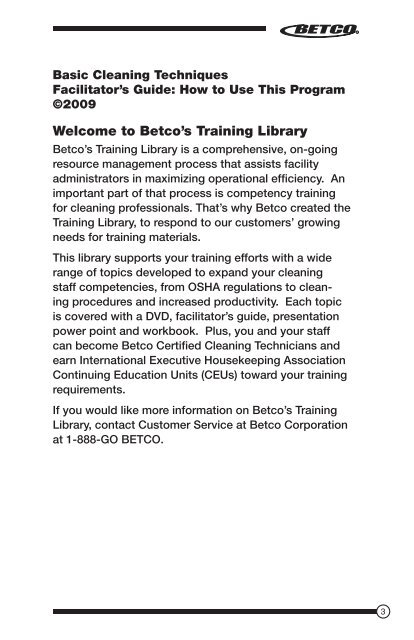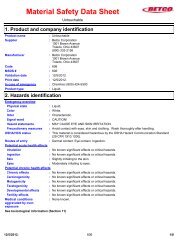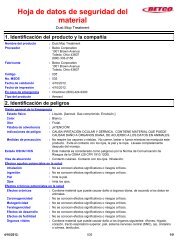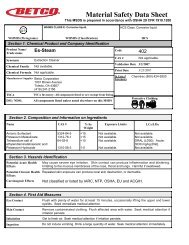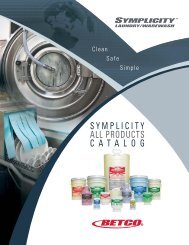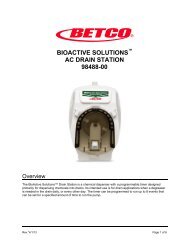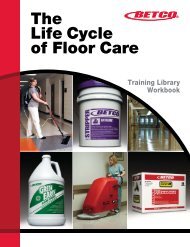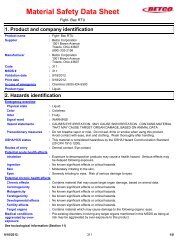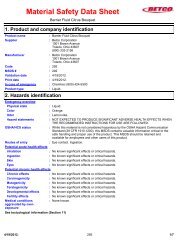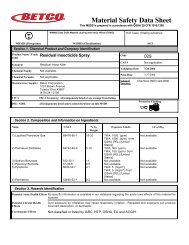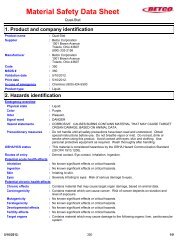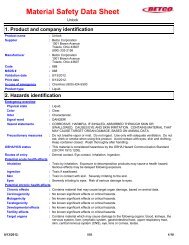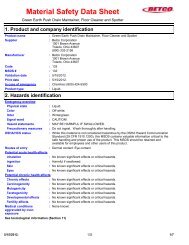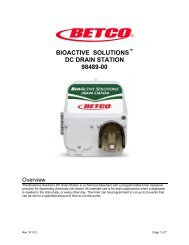Betco's Training Library - Betco Corporation
Betco's Training Library - Betco Corporation
Betco's Training Library - Betco Corporation
Create successful ePaper yourself
Turn your PDF publications into a flip-book with our unique Google optimized e-Paper software.
888-GO BETCO • www.betco.com<br />
Basic Cleaning Techniques<br />
Facilitator’s Guide: How to Use This Program<br />
©2009<br />
Welcome to <strong>Betco</strong>’s <strong>Training</strong> <strong>Library</strong><br />
<strong>Betco</strong>’s <strong>Training</strong> <strong>Library</strong> is a comprehensive, on-going<br />
resource management process that assists facility<br />
administrators in maximizing operational efficiency. An<br />
important part of that process is competency training<br />
for cleaning professionals. That’s why <strong>Betco</strong> created the<br />
<strong>Training</strong> <strong>Library</strong>, to respond to our customers’ growing<br />
needs for training materials.<br />
This library supports your training efforts with a wide<br />
range of topics developed to expand your cleaning<br />
staff competencies, from OSHA regulations to cleaning<br />
procedures and increased productivity. Each topic<br />
is covered with a DVD, facilitator’s guide, presentation<br />
power point and workbook. Plus, you and your staff<br />
can become <strong>Betco</strong> Certified Cleaning Technicians and<br />
earn International Executive Housekeeping Association<br />
Continuing Education Units (CEUs) toward your training<br />
requirements.<br />
If you would like more information on <strong>Betco</strong>’s <strong>Training</strong><br />
<strong>Library</strong>, contact Customer Service at <strong>Betco</strong> <strong>Corporation</strong><br />
at 1-888-GO BETCO.<br />
3
Brief Summary of This Program<br />
The Basic Cleaning Techniques module was developed<br />
to explain how to perform some of the most common<br />
cleaning tasks. This training will enhance the participant’s<br />
knowledge of cleaning techniques that will result<br />
in increased productivity, working smarter not harder,<br />
enhance worker safety and becoming a valuable cleaning<br />
professional.<br />
After participating in this program, the student<br />
should be able to:<br />
• Understand safety, preparation and basic<br />
cleaning information.<br />
• Perform many basic cleaning tasks.<br />
• Determine dilution ratios.<br />
• Realize the difference between daily, detail and<br />
project cleaning.<br />
• Successfully complete the certification exam.<br />
Program Materials:<br />
1 <strong>Training</strong> DVD Basic Cleaning Techniques<br />
Workbook<br />
Program Summary for User<br />
Supply Checklist<br />
Dilution Ration Exercises<br />
Certification Exam<br />
Facilitator’s Guide<br />
<strong>Training</strong> Tips for Facilitator<br />
Exam Key<br />
4
888-GO BETCO • www.betco.com<br />
Instructor Tips:<br />
The Instructors using the <strong>Betco</strong> <strong>Training</strong> <strong>Library</strong> repeatedly<br />
remark on the flexibility of the training materials.<br />
They appreciate having the ability to use the DVD for<br />
one-on-one and group instruction. The workbook has<br />
proven perfect for quick reviews before undertaking a<br />
procedure.<br />
The Basic Cleaning Techniques module is a process<br />
that requires integrating concepts and skills. When you<br />
are instructing your group, it is important that the library<br />
materials be accompanied with exercises, demonstrations<br />
and further discussion. Ultimately, the success of<br />
your students will rely on effective practice and follow-up<br />
after the formal training session(s).<br />
The following suggestions will help you<br />
conduct a successful, productive training<br />
session:<br />
1. Review the entire facilitator’s guide, workbook, power<br />
point and DVD before beginning a training session.<br />
Be familiar with how the workbook reiterates the<br />
points discussed in the DVD and power point. Make<br />
notes on any areas you want to explain further, or any<br />
points that may be slightly different at your facility.<br />
2. Note START and STOP points in the DVD program so<br />
you can relate to the information in the workbook and<br />
power point.<br />
3. Cite examples from your own experience whenever<br />
possible. This shows how the concepts aren’t merely<br />
textbook ideas, but that they are really applicable<br />
on-the-job.<br />
5
4. Encourage participation! Encourage the participants<br />
to ask questions if something isn’t clear, or to share<br />
their own experiences. Don’t force the issue though,<br />
since people learn in different ways, and some people<br />
don’t like to talk while they are learning something<br />
new.<br />
5. Exercises are a very valuable part of the learning<br />
experience. Remember to clearly explain the directions<br />
and make sure everyone understands what they<br />
are expected to do. Give the students enough time to<br />
complete each exercise.<br />
6. Encourage the participants to make notes in their<br />
workbook. These items are made for their future reference.<br />
Notes are an important way to personalize the<br />
information.<br />
7. Most participants have short attention spans. Try to<br />
emulate the audience’s normal activity flow. They<br />
are probably used to being active all day, so you may<br />
need to include additional activities to keep them<br />
mentally and physically alert. Take a break to stretch.<br />
Do some simple exercises. Instead of one long session,<br />
you may need to break it into 3 shorter sessions.<br />
The key to keeping your audience’s attention is to<br />
change activities every 7-10 minutes.<br />
It may also help to provide refreshments during the<br />
session. We have found it is seldom beneficial to<br />
have a full meal during a session, since people tend<br />
to be sluggish after eating that much. However, a light<br />
meal will probably enhance learning because it gives<br />
the students a chance to discuss the topic and apply<br />
it to their situation.<br />
6
888-GO BETCO • www.betco.com<br />
How to Use These Materials for a Group:<br />
This training program will be most effective if you plan<br />
for at least 2.0 hours of training time. This should include<br />
time for hands-on exercises, depending on the size of<br />
the group. There should be no interruptions, including<br />
pagers or cell-phones.<br />
For the Facilitator:<br />
1. Make sure you are familiar with the materials.<br />
2. Be available to answer any questions or concerns.<br />
3. Reinforce the process demonstrated on the DVD by<br />
discussing the information with the participant.<br />
4. Help the participant apply the information to your<br />
facility. Adapt the group exercises to a one-on-one<br />
situation if possible.<br />
5. Encourage the participant to demonstrate what they<br />
have learned, while you assist as needed.<br />
6. Provide plenty of time for the participant to cover the<br />
materials.<br />
They will need at least 1 hour to read the workbook,<br />
watch the video and take the certification exam in this<br />
program. They should be able to achieve certification<br />
on the module during that time. However, they will<br />
need additional time to practice the procedures outlined<br />
in the program.<br />
7. Encourage the participant to complete the module<br />
during one day. If they must stop, they should return<br />
to it soon. We find that the longer the participant<br />
stays away, the more information they will need to<br />
review before continuing.<br />
8. Review the following Self-Study tips with the<br />
participant.<br />
7
Self-Study Tips:<br />
Set aside at least 1 hour to read the workbook, watch<br />
the DVD and take the certification exam on this module.<br />
You should be able to achieve certification during this<br />
session. You will need additional time to practice the<br />
procedures outlined in the program.<br />
Try to complete the module during one day. If you must<br />
stop, return to it soon. We find that the longer you stay<br />
away, the more information you will need to review before<br />
you can continue.<br />
Self-Study Procedure:<br />
1. Review the workbook introduction.<br />
2. Go through the DVD.<br />
3. Think about how this process can be used at your<br />
facility.<br />
4. Review the critical steps in your workbook. Make<br />
notes as needed.<br />
5. Practice the process.<br />
6. Get feedback from your supervisor, your <strong>Betco</strong><br />
representative or another experienced person<br />
who can assist.<br />
7. Now you are ready to become a certified <strong>Betco</strong><br />
Basic Cleaning Specialist. Please take the time<br />
to complete the test for the module. If your test<br />
score is 80% correct, you receive a certificate<br />
from <strong>Betco</strong> and you will be eligible for IEHA<br />
CEU’s.<br />
8
888-GO BETCO • www.betco.com<br />
Take your certification exam on-line by going to www.<br />
betco.com. You can also complete the exam in the back<br />
of the workbook and mail or fax it to:<br />
<strong>Betco</strong> <strong>Corporation</strong><br />
Attn: Marketing<br />
P.O. Box 3127<br />
Toledo, OH 43607-0127<br />
FAX: 419-321-1954<br />
Set Up Room:<br />
Seating — Use chairs and tables so the students<br />
can layout their workbooks on the table. Make sure<br />
all of the seats have a good view of the audiovisual<br />
equipment.<br />
Equipment — using the DVD, you will need a computer<br />
with a DVD drive. If you have a large audience,<br />
it will help to have a projector that hooks into the<br />
computer.<br />
Assemble Demonstration Products and Equipment,<br />
including used in your facility:<br />
Gather cleaning tools such as high duster, mop and<br />
bucket, squeegee, dust mop, cleaning cloths and<br />
sponges.<br />
Remember to include the proper PPE and caution signs.<br />
Develop <strong>Training</strong> Aids:<br />
Flip Chart/Chalk Board — Use a flip chart or chalkboard<br />
to list the main points of your presentation.<br />
This will provide a set of guidelines for both you and<br />
your audience.<br />
9
<strong>Training</strong> Session (1 hour)<br />
1. Introduction of Basic Cleaning Techniques module<br />
Use Section 1 of the workbook to introduce the<br />
program.<br />
2. Go around the room and ask each participant<br />
what they want to learn from this session. Write<br />
their answers on a flip chart and post the page in<br />
the room. You will refer to this at the end of the<br />
session.<br />
3. Discuss the process and product applications.<br />
4. Use the step-by-step instructions in the workbook<br />
to discuss the process and product applications.<br />
5. Show the DVD.<br />
6. Discuss the DVD and power point as it applies to<br />
your facility. Start by asking the participants how<br />
they think it applies to your facility.<br />
7. Complete hands-on demonstrations. Have each<br />
participant or a couple participants practice the<br />
steps outlined in the training. If you only have<br />
time to practice a few be sure to review the more<br />
difficult tasks such as windows, dilution control<br />
and proper mopping procedures.<br />
8. Review the certification questions with a verbal<br />
pre-exam. You may want to use the exam<br />
questions without the multiple-choice answers.<br />
Remember, they must get 80% of the questions<br />
right to gain certification, so you want to<br />
make sure they understand why the answers are<br />
correct.<br />
10
888-GO BETCO • www.betco.com<br />
9. Review the flip chart page listing what they<br />
wanted to learn during this session. Make<br />
sure you have discussed their concerns,<br />
even if they are off of this topic.<br />
10. You may facilitate the certification exam<br />
process by handing out copies of the exam<br />
and conducting a traditional testing situation.<br />
You can send or fax the exams to <strong>Betco</strong> for<br />
evaluation. Or, you can set up time for the<br />
participants to take the exam on-line.<br />
Additional Comments:<br />
It may be difficult to get the participants to answer<br />
questions. We find that simple rewards work wonders.<br />
Our experienced trainers have used a wide<br />
variety of rewards for correct answers, from candy<br />
bars to <strong>Betco</strong> hats to dollar bills.<br />
Making the training experience fun and rewarding<br />
will help participants retain the information, look<br />
forward to future training classes and instill a positive<br />
attitude toward their job.<br />
11
Other <strong>Betco</strong> <strong>Training</strong> <strong>Library</strong> Modules:<br />
OSHA Hazard Communication*<br />
OSHA Bloodborne Pathogen*<br />
Slip and Fall Prevention<br />
Restroom Sanitation<br />
Proper Hand Washing*<br />
The Life Cycle of Floor Care*<br />
The Life Cycle of Carpet Care<br />
Patient Room Disinfection<br />
Educational Facility Disinfection<br />
Sports Zone wood floor care*<br />
*Available in Spanish<br />
12
888-GO BETCO • www.betco.com<br />
How to Calculate Dilution Ratios:<br />
Dilution ratios are expressed in two ways, either 1 to a given<br />
number (such as 1:64) or in terms of ounces per gallon (2<br />
ounces per gallon).<br />
If you need to calculate the ounces per gallon remember<br />
that there are 128 ounces in a gallon, so a 1 ounce per gallon<br />
product dilutes at a ratio of 1:128 and ½ and ¼ ounce products<br />
dilute at 1:256 and 1:512 respectively. A common method to<br />
determine ounces per gallon is to take 128 and divide it by the<br />
ratio number. For instance, a product that has a dilution ratio of<br />
1:256 would be calculated like this:<br />
128 ÷ 256 = .5 ounces per gallon<br />
Some of the more common ratios are provided in the table<br />
below:<br />
Ounce per gallon<br />
¼ ounce per gallon 1:512<br />
½ ounce per gallon 1:256<br />
1 ounce per gallon 1:128<br />
2 ounces per gallon 1:64<br />
4 ounces per gallon 1:32<br />
Dilution Ratios<br />
5 ounces per gallon 1:26 (1:25.6 rounded)<br />
6 ounces per gallon 1:21 (commonly considered<br />
1:20)<br />
8 ounces per gallon 1:16<br />
12 ounces per gallon :10<br />
13
14<br />
If a product has a ratio of 1:128 you would mix one part of the<br />
product to 128 parts of water. That means that the gallon of<br />
product will make 129 total gallons of solution because to mix<br />
it properly you would take the gallon of product and add 128<br />
gallons of water which equals 129 total gallons. A 1:256 product<br />
makes 257 gallons of end use solution and a 1:64 makes 65<br />
gallons of solution. The total amount of solution that a given<br />
container of product makes is commonly referred to as the yield.<br />
Metric calculations such as liters can be calculate, you just<br />
need to convert the metric figures to gallons or ounces prior<br />
to starting. Common metric volume measurements and there<br />
English equivalents are listed below:<br />
1 quart = 0.946 mL<br />
1 gallon = 3.785 liters<br />
1 liter = 0.264 gallons<br />
4 liters = 1.056 gallons<br />
Take a few minutes to complete the following<br />
exercises.<br />
1. How many ounces per gallon are equivalent to Deep<br />
Blue Glass cleaner at 1:30<br />
4.27<br />
2. How much ready to use (RTU) gallon yield can be made<br />
from a gallon of Deep Blue glass cleaner at a dilution<br />
ratio of 1:30<br />
31 RTU gallons<br />
3. How many ounces per gallon are equivalent to pH7 All<br />
Purpose Neutral Cleaner at 1:64<br />
2<br />
4. How much RTU gallon yield would you get from a five<br />
gallon pail of pH7Q Ultra at 1:256<br />
1285 RTU gallons
888-GO BETCO • www.betco.com<br />
Certification Exam:<br />
The following exam will certify the person taking it as an<br />
official <strong>Betco</strong> Basic Cleaning Specialist. Please make<br />
sure each person you teach takes the exam. The exam<br />
can be taken on-line, through www.betco.com. You can<br />
also hand out a paper copy of the test, then send or fax<br />
the completed tests to:<br />
<strong>Betco</strong> <strong>Corporation</strong><br />
Attn: Marketing<br />
P.O. Box 3127<br />
Toledo, OH 43607-0127<br />
FAX: 419-321-1954<br />
Basic Cleaning Techniques Exam Key<br />
IEHA Course Number: 010710x Credit Hours: .20 CEU’s<br />
1. Always store heavier items on the top shelf.<br />
True<br />
False<br />
2. Before using any chemical you should:<br />
Test it on an inconspicuous area<br />
Check the expiration date<br />
Read the MSDS and manufacturer’s label<br />
3. When cleaning you should:<br />
Clean from top to bottom<br />
Use a pattern<br />
Damp wipe all surfaces<br />
Both a and b<br />
4. When mopping:<br />
Soak the mop head until it is very wet<br />
Start from the furthest corner and work<br />
toward the door<br />
Spray the mop with mop treatment<br />
Both a and c<br />
5. What are the two basic techniques to wiping<br />
Sponge wiping and cloth wiping<br />
Damp wiping and spray and wiping<br />
Spray wiping and cloth wiping<br />
15
6. When using a disinfectant you should:<br />
Allow for the proper contact time<br />
Always use a sponge<br />
Wipe immediately<br />
7. Which wiping method would you most likely use<br />
when cleaning a toilet<br />
Sponge wiping<br />
Damp wiping<br />
Spray and wiping<br />
8. Learning to use the correct wiping technique can<br />
save time, decrease product usage and limit<br />
chemical exposure.<br />
True<br />
False<br />
9. When dusting furniture:<br />
Start at the largest fixtures and work<br />
toward the smallest<br />
Wipe from top to bottom working<br />
clockwise around the room<br />
Post caution signs<br />
All of the above<br />
10. Taking the squeegee along the top of the glass<br />
from side to side after wetting is referred as:<br />
Slicing the solution<br />
Preparing the squeegee<br />
Cutting the water<br />
11. A pH of 12 is an alkaline cleaner<br />
True<br />
False<br />
12. What are the characteristics of cleaner<br />
Wetting<br />
Penetration<br />
Emulsification<br />
Rinsing<br />
All of the above<br />
13. It is a best practice to work in the same direction<br />
when cleaning an area<br />
True<br />
False<br />
16
888-GO BETCO • www.betco.com<br />
14. Before wet mopping a floor you should always:<br />
Post caution signs<br />
Dust mop<br />
All of the above<br />
15. When wet mopping:<br />
Swing the mop back and forth in wide<br />
deliberate strokes<br />
Use a figure 8 stroke<br />
Hold the handle firmly in a 45 degree angle<br />
16. The frequent cleaning of highly visible areas<br />
of a facility is referred to as:<br />
Policing<br />
Patrolling<br />
Trafficking<br />
17. How many ounces per gallon do you need of a<br />
product that’s dilution ratio is 1:16<br />
¼ ounce<br />
4 ounces<br />
8 ounces<br />
none of the above<br />
18. The yield for a gallon of product that has a ratio of<br />
1:128<br />
128 gallons of end-use product<br />
129 gallons of end-use product<br />
256 gallons of end-use product<br />
19. According to this training, detail cleaning is usually<br />
performed how often<br />
Once a month<br />
Twice a year<br />
As much as possible<br />
20. After learning more about the basic cleaning<br />
techniques you should be:<br />
More knowledgeable<br />
Proud<br />
Helpful in creating a safe<br />
and healthy work environment<br />
All of the above<br />
17
IEHA Accreditation:<br />
This course is worth .20 Continuing Education Units<br />
awarded by the International Executive Housekeeping<br />
Association (IEHA). To earn these credits, submit a copy<br />
of the certificate to your local IEHA chapter.<br />
Reorder Information:<br />
To order additional copies of workbooks, call 1-888-GO<br />
BETCO and request reorder #90891. Workbooks come<br />
in packages of 10. To order additional Basic Cleaning<br />
Techniques DVDs refer to reorder #90890. Our customer<br />
service representatives can provide information on<br />
pricing.<br />
18


